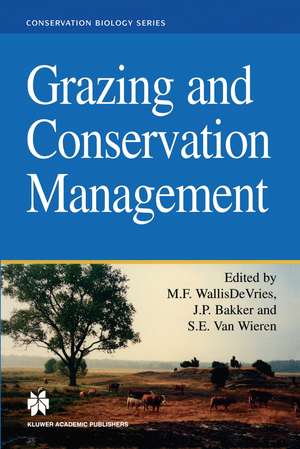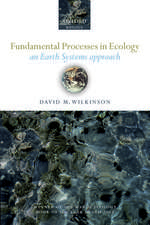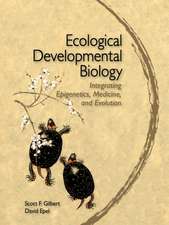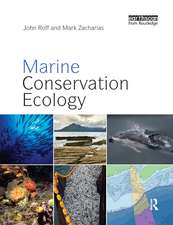Grazing and Conservation Management: Conservation Biology, cartea 11
Editat de Michiel F. WallisDe Vries, Jan P. Bakker, Sipke E. Van Wierenen Limba Engleză Paperback – 12 noi 2012
Grazing and Conservation Management will appeal to conservation biologists and rangeland managers, providing them with a clearer understanding of grazing and conservation management.
Din seria Conservation Biology
- 11%
 Preț: 510.79 lei
Preț: 510.79 lei -
 Preț: 396.12 lei
Preț: 396.12 lei - 11%
 Preț: 474.83 lei
Preț: 474.83 lei - 18%
 Preț: 997.88 lei
Preț: 997.88 lei -
 Preț: 428.90 lei
Preț: 428.90 lei - 18%
 Preț: 957.44 lei
Preț: 957.44 lei - 11%
 Preț: 511.40 lei
Preț: 511.40 lei - 11%
 Preț: 521.80 lei
Preț: 521.80 lei - 18%
 Preț: 1233.37 lei
Preț: 1233.37 lei - 11%
 Preț: 519.62 lei
Preț: 519.62 lei - 11%
 Preț: 482.28 lei
Preț: 482.28 lei - 18%
 Preț: 948.92 lei
Preț: 948.92 lei - 11%
 Preț: 599.15 lei
Preț: 599.15 lei - 14%
 Preț: 772.46 lei
Preț: 772.46 lei - 11%
 Preț: 425.79 lei
Preț: 425.79 lei - 15%
 Preț: 644.49 lei
Preț: 644.49 lei - 11%
 Preț: 526.94 lei
Preț: 526.94 lei - 11%
 Preț: 597.21 lei
Preț: 597.21 lei -
 Preț: 373.96 lei
Preț: 373.96 lei -
 Preț: 364.04 lei
Preț: 364.04 lei - 11%
 Preț: 475.17 lei
Preț: 475.17 lei - 15%
 Preț: 646.62 lei
Preț: 646.62 lei - 11%
 Preț: 505.11 lei
Preț: 505.11 lei - 18%
 Preț: 942.94 lei
Preț: 942.94 lei - 11%
 Preț: 600.56 lei
Preț: 600.56 lei - 24%
 Preț: 1058.91 lei
Preț: 1058.91 lei - 18%
 Preț: 1240.62 lei
Preț: 1240.62 lei - 11%
 Preț: 513.79 lei
Preț: 513.79 lei -
 Preț: 459.88 lei
Preț: 459.88 lei - 18%
 Preț: 944.36 lei
Preț: 944.36 lei - 24%
 Preț: 790.95 lei
Preț: 790.95 lei - 11%
 Preț: 567.97 lei
Preț: 567.97 lei
Preț: 532.38 lei
Preț vechi: 626.33 lei
-15% Nou
Puncte Express: 799
Preț estimativ în valută:
101.90€ • 105.98$ • 85.39£
101.90€ • 105.98$ • 85.39£
Carte tipărită la comandă
Livrare economică 14-28 martie
Preluare comenzi: 021 569.72.76
Specificații
ISBN-13: 9789401058865
ISBN-10: 9401058865
Pagini: 396
Ilustrații: XVI, 374 p.
Dimensiuni: 155 x 235 x 21 mm
Greutate: 0.55 kg
Ediția:1998
Editura: SPRINGER NETHERLANDS
Colecția Springer
Seria Conservation Biology
Locul publicării:Dordrecht, Netherlands
ISBN-10: 9401058865
Pagini: 396
Ilustrații: XVI, 374 p.
Dimensiuni: 155 x 235 x 21 mm
Greutate: 0.55 kg
Ediția:1998
Editura: SPRINGER NETHERLANDS
Colecția Springer
Seria Conservation Biology
Locul publicării:Dordrecht, Netherlands
Public țintă
ResearchCuprins
1 Large herbivores as key factors for nature conservation.- One Historical and Ecological Background.- 2 Grazing for conservation management in historical perspective.- 3 Origins and development of grassland communities in northwestern Europe.- 4 Effects of human interference on the landscape with special reference to the role of grazing livestock.- Two Impact of Grazing on Community Structure.- 5 The impact of grazing on plant communities.- 6 Effects of large herbivores upon the animal community.- Three Management Applications.- 7 Hydrological conditions and herbivory as key operators for ecosystem development in Dutch artificial wetlands.- 8 The practical use of grazing in nature reserves in The Netherlands.- Four Perspectives and Limitations.- 9 Habitat quality and the performance of large herbivores.- 10 The role of scientific models.- 11 Grazing for conservation in the twenty-first century.
















